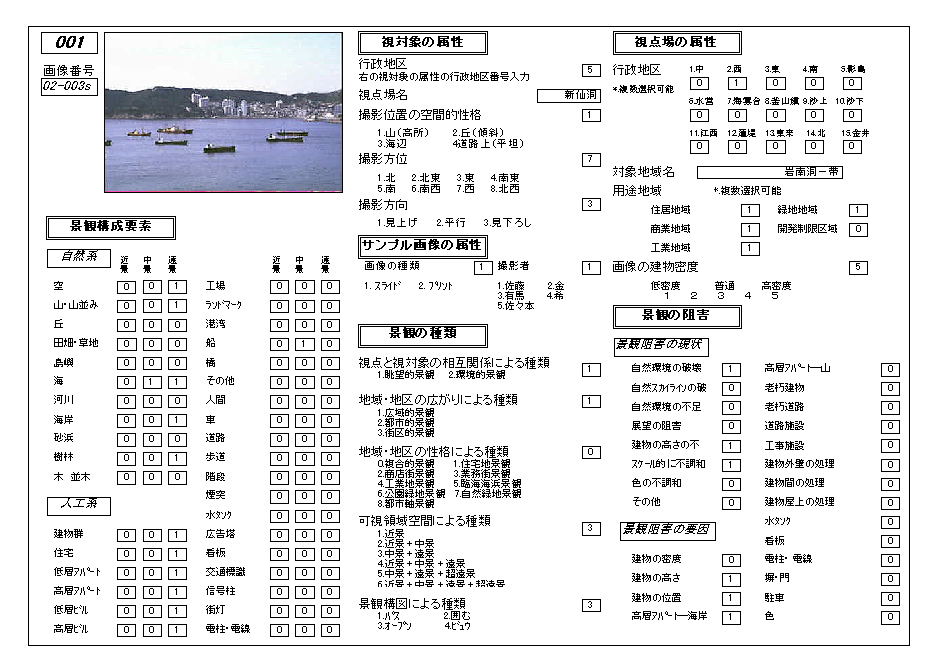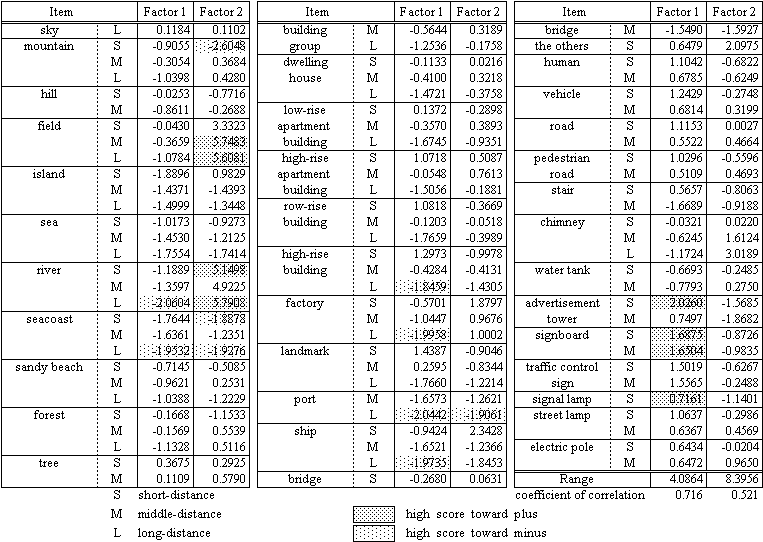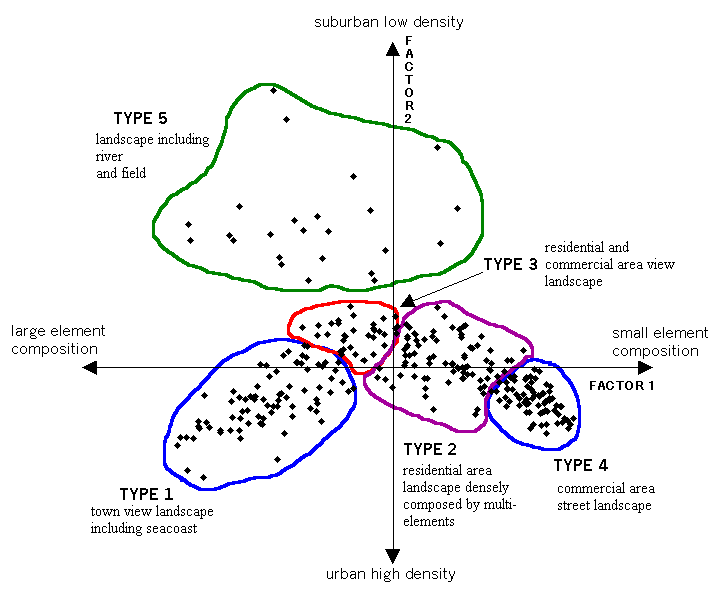| ü@ |
PAPER 1997 Year |
|
|
ü@ ü@
ü@
ü@
|
ü@ Evaluation of the Urban Landscape in Pusan by multivariate analysis ü@ ü@ 1.ABSTRACT ü@ ü@ü@The main purpose of this paper is to develop a method to clarify characteristics of urban landscape using a picture database system and to evaluate the urban landscape of Pusan by means of multivariate analysis. In this study, the following items were analyzed to evaluate the relation between landscape attribute and landscape composition . As the first step, we construct the Landscape Picture Database System which can combine a picture and its attribute data in order to synthetically analyze a large quantity of image data and its characteristics. Second step, urban landscape was analyzed by the " Hayashi's quantification theory ćV" a multivariate analysis method. As a result, the urban landscape was classified into 5 types: (1)town view landscape including seacoast, (2)residential area landscape densely composed by multi-elements, (3)residential and commercial area view landscape, (4)commercial area street landscape, (5)landscape including river and field. ü@ ü@ 2.INTRODUCTION ü@ Pusan, the biggest international port city in Korea, lies on the southeast coast of the Korean peninsula. It has achieved a rapid growth over the last 50 years, with its population increasing from 280,000 to 4 million. Mountainous topographical conditions, rapid urbanization, and green-belt districts of original Korean urban planning system created a dense urban space with many high-rise buildings. At present, there is increasing interest the urban landscape which is part of the living environment, and so it is important to grasp the present state of the urban landscape. In order to make effective landscape control regulations which maintain the original landscape, this study examines the characteristics of the landscape composition element in Pusan city using the landscape picture database. ü@ ü@ 3.BUILDING PICTURE DATABASE FOR LANDSCAPE EVALUATION ü@ 1)Setting the view
point ü@ 2)Organization of
landscape picture database ü@ 4.CLASSIFICATION OF URBAN LANDSCAPE IN PUSAN CITY By using the following data, the urban landscape in Pusan city was classified according to the landscape composition elements and by distance. We established landscape distances as follows: short-distance landscape is 0-200 meters, meddle-distance landscape is 200-1,000 meters, and long-distance landscape is beyond 1,000 meters. Landscape composition elements consist of 11 natural composition elements and 25 artificial composition elements were divided into 3 distance categories. This study analyzes the characteristics of the landscape composition element in Pusan city using the " Hayashi's quantification theory ćV". ü@ 1)Basic concept of
urban landscape in Pusan ü@ ü@ ü@ 2)Classification
landscape in Pusan ü@ Type 1 ; Town view landscape
including seacoast The elements of sea, mountain and building group in the
long-distance are common with the obtained landscapes. Especially, the
appearance frequency distribution of sea is higher than any other type. ü@ Type 2 ; Residential area
landscape densely composed by multi-elements ü@ü@The short- distance landscape
elements is vehicle, road and electric pole in high ratio of appearance
frequency. Middle-distance landscape is house, apartment building, and low-rise
building. ü@ Type 3 ; Residential and commercial area view landscapeü@ The elements of mountain in middle-distance and long-distance, and building in long-distance are common to obtained landscapes. Representative photographs are the view landscape overlooking the combined residential and commercial area. ü@ Type 4 ; Commercial area street landscape ü@The elements of road, sign board, electric pole, vehicle and low-rise building are common to obtained landscapes. Representative photographs are the commercial area's street landscape. Composition of this type landscape is from the street landscape perspective. ü@ Type 5 ; Landscape including river and field ü@ The elements of field, river and mountain are common with the obtained landscapes. Especially, the appearance frequency distribution of field, river, is higher than any other type. And concerning elements of the long-distance, the appearance frequency of building group, high-rise apartment building and factory is slightly high. Composition of this type is the open landscape. ü@ ü@ 5.CONCLUSION It is clear that this landscape picture database system which is a method clarified characteristics of urban landscape is effective. We obtained that the urban landscape consists of two factors as follows: the one is large element-small element composition axis which represents various forms of urban landscape in Pusan city, and the other is the town high density-suburban low density axis which represents unique land using system and topographical character of Pusan city. The urban landscape is classified by these factors into 5 types. Using a multivariate analysis for landscape evaluation, the comprehensive information on the characteristics of landscape in Pusan are proposed. ü@ ü@ REFERENCE HAGISHIMA, S. and OHGAI, A. (1990),
"A study of the urban landscape in the 19C european landscape
paintings", Journal of Archit. Plann. Environ. Engng, ALJ, No 413 ü@ |



